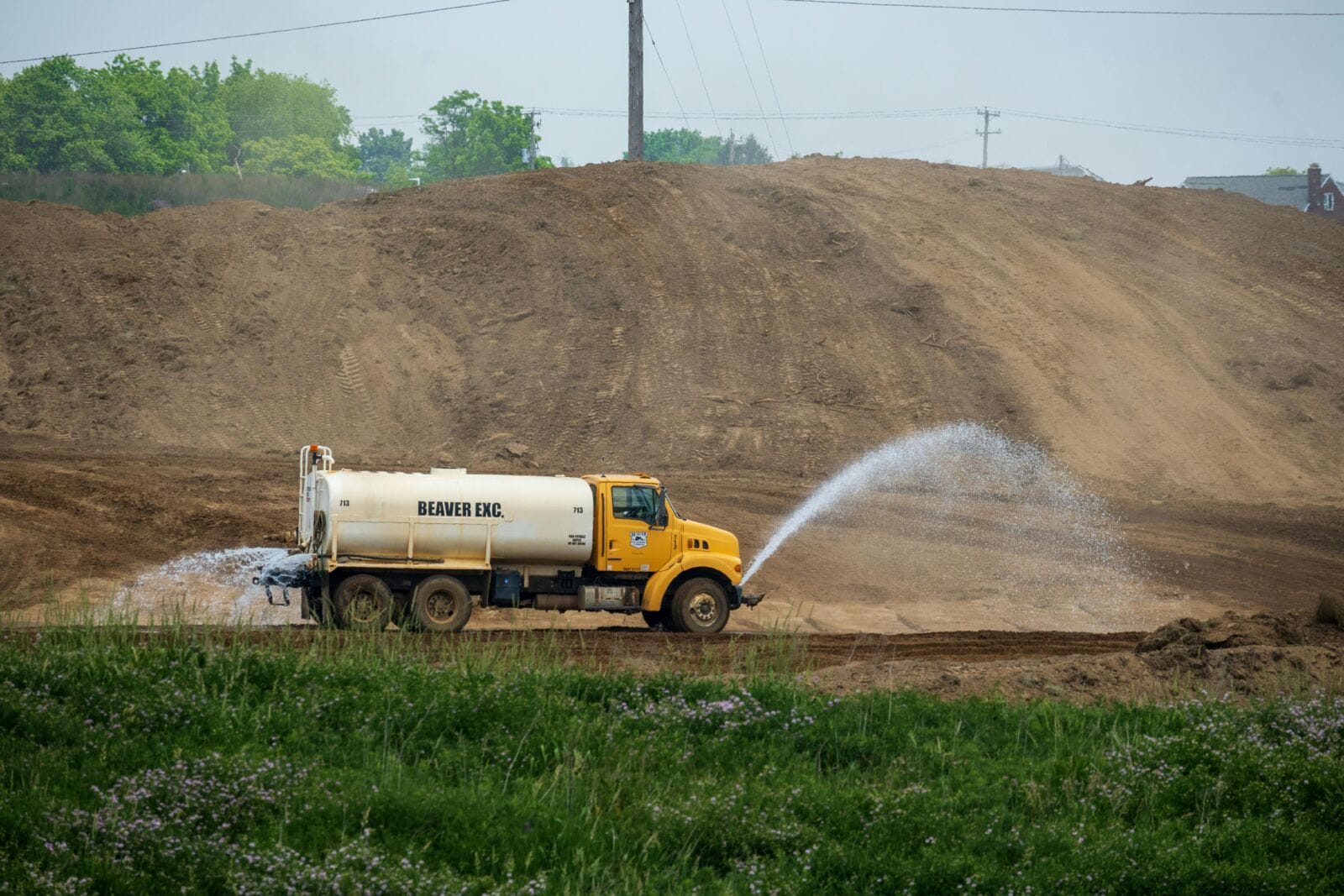If your truck water cartage tank is not properly draining, it could be for several reasons. You may be dealing with build-up or physical obstructions, air-locking, inadequate pressure, or perhaps the drain valve itself may be faulty or damaged.
Whatever the cause, detecting and addressing the issue promptly can safeguard your tank’s lifespan and ensure consistent operation.
Firstly, inspect thoroughly for visible signs of obstruction. This can usually be within the hoses, fittings, or the valve itself. Build-up from sediments or particles can often inhibit effective drainage in your water cartage tanks. If any obstruction is found, it must be promptly removed.
Also, a lack of adequate pressure can contribute to ineffective drainage. To rectify this, you may need to cap off some of the outlets or even redistribute the flow.
If these attempts do not fix the issue, the problem could be more serious and you may require professional assistance. Don’t hesitate to give them a call when in need.
Identifying Drainage Issues
A critical part of truck water cartage tank maintenance includes being observant of any slow draining issues. Improper drainage can often provide an early warning of significant problems brewing in your system. Unsuitably maintained drain valves are the culprits in up to 25% of slow draining problems with truck water cartage tanks.
You must take steps once you notice your tank is not draining as it should. Ignoring this sign can lead to numerous complications, ranging from minor inconveniences to potential damage to your tank, which can result in costly repairs or replacements.
- Investigate the drain valve: Ensure it is open and functioning correctly. If its operation seems sluggish or hindered, proper cleaning or replacement may be needed.
- Clean the tank regularly: Regular cleaning allows you to spot any build-up that might obstruct the drain valve, ensuring that it continues to work effectively.
- Inspect for blockages: Check your tank for any obstructions that might be causing slow drainage. This could range from debris within the-tank to a kink or a bend in the outflow pipe.
Paying attention to these key areas significantly minimizes the risk of dealing with stalled work or potential damage due to improperly drained truck water cartage tanks. As such, regular maintenance checks are integral for efficient operations and longevity of your equipment.
Consulting Truck Manuals
Referencing your truck’s manuals can offer valuable insight on the necessary steps to troubleshoot and fix your water cartage tank. Understanding the specific manufacturer’s guidelines for maintaining your equipment is key to ensuring proper functionality over time.
The manual often provides specific details about the water cartage tank, including the optimal drain rate, common issues and their solutions, as well as tips and recommendations for optimal operation.
Understanding Drain Valve Sizes
Determining the size of your drain valve forms a crucial part in diagnosing drainage problems. Different sizes of valves have varying drainage rates, which directly affects how efficiently your tank drains.
A study showed that using a 3-inch diameter drain valve could drain a 2,500-gallon tank in approximately 15-20 minutes, whereas a 2-inch diameter valve could take up to 30-40 minutes. Be cognizant of these variations as they influence your troubleshooting techniques.
Inspection and Maintenance
A thorough inspection of your tank’s outlet system is vital to target potential blockages or faults. Regular maintenance checks and clean-up operations will prevent sediment accumulation, ultimately guarding against improper draining.
Your truck manuals should provide directions for routine checkups. Stick to them closely for ensuring smooth operation and longevity of your tank and its components.
Inspecting the Tank
When you suspect your truck’s water cartage tank isn’t draining properly, it’s critical to promptly inspect the internal and external structures. The primary focus should be on pinpointing any obstructions in the drain outlet or pipe because this is a common cause of poor drainage.
Sometimes flushing out your tank may clear minor obstructions, helping restore normal operation. However, if this doesn’t work, you might need professional assistance to dismantle and repair the components.
- Check for Debris: Sediment build-up or lodged debris could clog the drain outlet.
- Assess Seals and Gaskets: Compromised gaskets or seals can negatively impact the drainage.
To attain improved drainage results, consider equipping your water tank with modern technology. In particular, adopting variable-frequency drive (VFD) pump controls might offer substantial benefits.
The use of VFD pump controls can help save up to 50% in energy costs compared to traditional fixed-speed pumps and can lead to more efficient water tank draining times.
Making such an upgrade means proactively addressing drainage issues before they escalate to major operational hitches. Therefore, taking such decisive measures helps maintain your water cartage tank in good shape while saving valuable time and resources.
In identifying potential problems early enough through regular inspection protocols, you promote efficient operation of your truck’s water cartage system which will ultimately prolong its lifespan.
Performing Tank Maintenance
Your truck water cartage tank requires ongoing upkeep. Proper maintenance ensures efficient draining, especially vital if your truck has a maximum capacity of up to 36,000 liters (9,500 gallons). Here we’ll outline key maintenance steps.
Initially, examine the drain plug area. Debris accumulation could hinder proper outflow. This issue usually arises after frequent use and might need meticulous cleaning.
| Maintenance Action | Frequency |
| Inspect Drain Plug Area | After Each Use |
| Clean Accumulated Debris | Monthly |
| Complete Tank Flush | Semi-Annually |
| Pipe Network Scrubbing | Annually |
| *Table of Routine Maintenance for Truck Water Cartage Tanks* | |
The composed table outlines the vital maintenance tasks alongside each respective frequency. Consistently following this schedule aids in attaining optimal tank output.
Another essential step is regular tank flushing and pipe network scrubbing. These actions prevent mineral buildup and blockages. Devising a routine for these procedures can immensely avert draining complications.
Remember, any inconsistencies during maintenance may affect your truck’s overall performance. Therefore, it’s essential you administer upkeep periodically to ensure a safe and efficient operation.
Professional Drainage Solution
If your water cartage tank is not draining properly, consider enlisting professional help. Not only can they quickly diagnose the problem, but they also have the tools and expertise to fix it efficiently.
Contracting a professional drainage service delivers multiple benefits. That includes ensuring that the issue will not recur in the future. They may identify underlying issues that may possibly escalate if left undetected.
- Detecting Hidden Issues: Professionals are skilled in finding hidden issues that could be causing drainage problems.
- Preventing Future Problems: With their experience, professionals can provide advice on how to prevent future drainage complications.
- Saving Time and Money: Fixing the problem yourself might cause further damage, resulting in more expenses and wasted time.
Time is a crucial aspect when dealing with water cartage tank issues. The longer you leave it untreated, the worse it could potentially become. Professional assistance expedites the resolution.
Scheduling Regular Check-ups
Your truck’s water cartage tank is essential for transporting water. Decentralizing water sources and using more on-site water cartage trucks can reduce water transportation costs by up to 30%, but this also increases the demand on efficient water tank draining. To ensure your tank functions properly, arrange regular check-ups.
Regular inspections can promptly detect issues before they escalate. Most importantly, you need to stay alert for any signs that your tank isn’t draining properly. Here are some clues that could hint at a potential problem:
- Stagnant Water: If water remains in the tank after drainage, something could be obstructing its exit.
- Inconsistent Flow: A fluctuating stream suggests an issue with the drain’s mechanism.
- Poor Water Quality: Impurities, odd coloration, or an unusual smell might indicate contamination or decay inside the tank.
Equipped with this information, you can stay vigilant for any telltale signs of a problem. Always remember prevention is better than cure when it comes to maintaining your truck’s water cartage tank.
Avoid unnecessary repair costs by committing to regular preventive maintenance. This method helps increase operational effectiveness and long-term productivity of your truck’s drainage system. So, keeping your tanker in prime condition should be a top priority.
Preventing Drainage Problems
Your truck’s water cartage tank may not be draining correctly due to a variety of problems. By establishing routine check-ups and maintenance, you can avoid these issues and ensure the tank drains properly.
Maintaining Drain Valves
To start with, often inspect the drain valves. These are particularly vulnerable to wear and tear due to regular use. Note any unusual occurrences such as slow drainage.
Ensure these valves are free from blockages. Anything from debris to hard water deposits can accumulate here, preventing smooth drainage.
Checking Pump Functionality
Another thing to monitor is the functionality of your pump. Pumps facilitate the movement of water in and out of the tank. A dysfunctioning pump will affect draining speed significantly.
If the average time required to drain a water cartage tank takes longer than an hour, this could be a sign your pump needs attention. Regular cleaning and supervision can help increase its lifetime and performance.
Evaluating Tank Condition
The condition of your tank plays a significant role in proper drainage as well. Rust or corrosion inside the tank will lead to issues with drainage.
Annual inspections can help detect these problems early on. If noticed early enough, these issues can often be rectified without replacing the whole unit.
Frequent Cleaning
Last but not least, frequently clean your tank. This helps in preventing accumulation of debris that might lead to clogging and subsequent slow draining.
An effective cleaning regimen comprises emptying the tank fully, scrubbing it using suitable cleansers, thoroughly rinsing then allowing it to dry before use.
Tank Draining Troubles?
If your truck’s water cartage tank is experiencing draining issues, it could be due to a variety of causes. Determine the problem; it might stem from blockage or mechanical failure.




